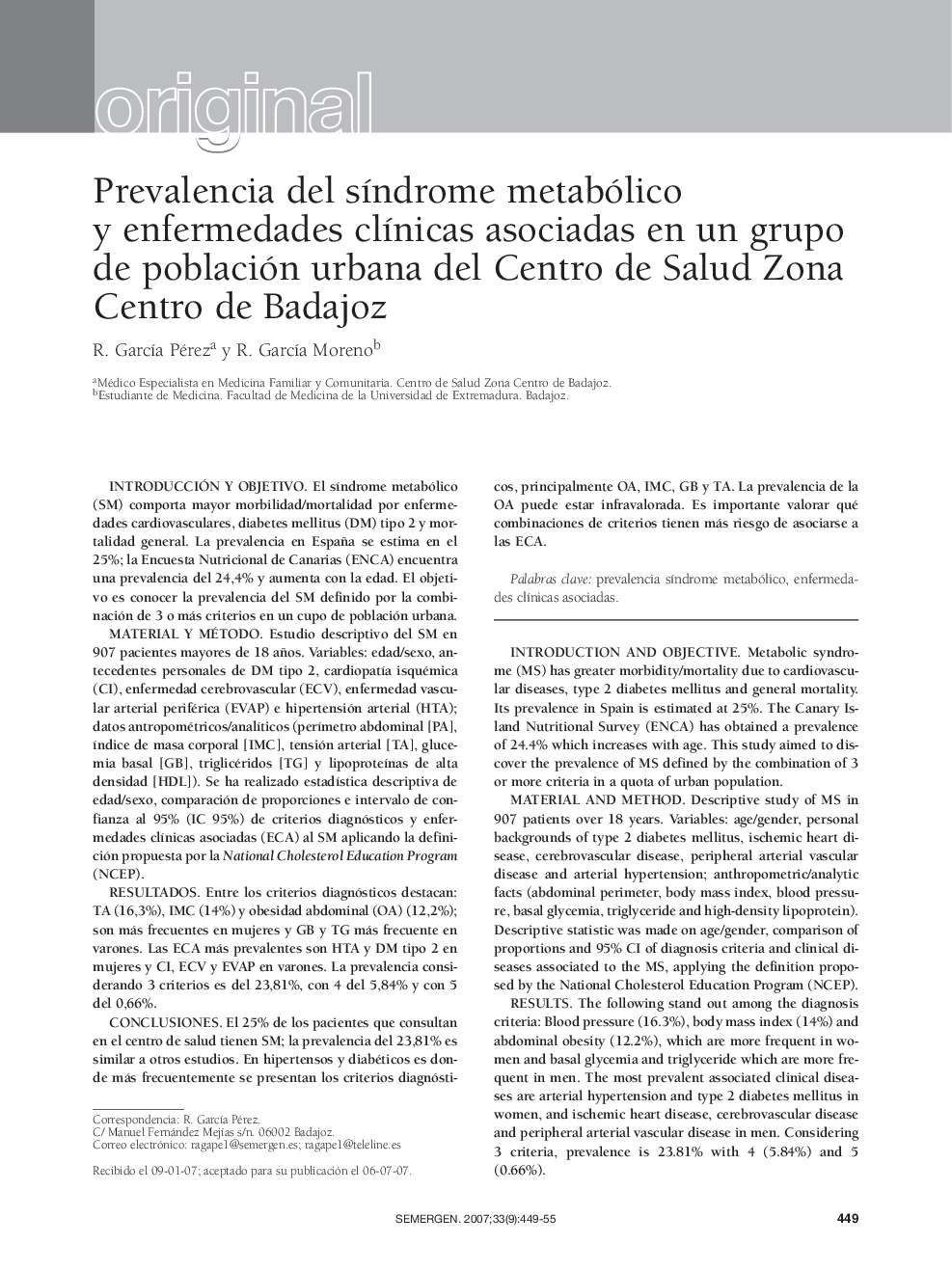| Article ID | Journal | Published Year | Pages | File Type |
|---|---|---|---|---|
| 3835830 | SEMERGEN - Medicina de Familia | 2007 | 7 Pages |
Introducción y objetivoEl sÃndrome metabólico (SM) comporta mayor morbilidad/mortalidad por enfermedades cardiovasculares, diabetes mellitus (DM) tipo 2 y mortalidad general. La prevalencia en España se estima en el 25%; la Encuesta Nutricional de Canarias (ENCA) encuentra una prevalencia del 24,4% y aumenta con la edad. El objetivo es conocer la prevalencia del SM definido por la combinación de 3 o más criterios en un cupo de población urbana.Material y métodoEstudio descriptivo del SM en 907 pacientes mayores de 18 años. Variables: edad/sexo, antecedentes personales de DM tipo 2, cardiopatÃa isquémica (CI), enfermedad cerebrovascular (ECV), enfermedad vascular arterial periférica (EVAP) e hipertensión arterial (HTA); datos antropométricos/analÃticos (perÃmetro abdominal [PA], Ãndice de masa corporal [IMC], tensión arterial [TA], glucemia basal [GB], triglicéridos [TG] y lipoproteÃnas de alta densidad [HDL]). Se ha realizado estadÃstica descriptiva de edad/sexo, comparación de proporciones e intervalo de confianza al 95% (IC 95%) de criterios diagnósticos y enfermedades clÃnicas asociadas (ECA) al SM aplicando la definición propuesta por la National Cholesterol Education Program (NCEP).ResultadosEntre los criterios diagnósticos destacan: TA (16,3%), IMC (14%) y obesidad abdominal (OA) (12,2%); son más frecuentes en mujeres y GB y TG más frecuente en varones. Las ECA más prevalentes son HTA y DM tipo 2 en mujeres y CI, ECV y EVAP en varones. La prevalencia considerando 3 criterios es del 23,81%, con 4 del 5,84% y con 5 del 0,66%.ConclusionesEl 25% de los pacientes que consultan en el centro de salud tienen SM; la prevalencia del 23,81% es similar a otros estudios. En hipertensos y diabéticos es donde más frecuentemente se presentan los criterios diagnósticos, principalmente OA, IMC, GB y TA. La prevalencia de la OA puede estar infravalorada. Es importante valorar qué combinaciones de criterios tienen más riesgo de asociarse a las ECA.
Introduction and objectiveMetabolic syndrome (MS) has greater morbidity/mortality due to cardiovascular diseases, type 2 diabetes mellitus and general mortality. Its prevalence in Spain is estimated at 25%. The Canary Island Nutritional Survey (ENCA) has obtained a prevalence of 24.4% which increases with age. This study aimed to discover the prevalence of MS defined by the combination of 3 or more criteria in a quota of urban population.Material and methodDescriptive study of MS in 907 patients over 18 years. Variables: age/gender, personal backgrounds of type 2 diabetes mellitus, ischemic heart disease, cerebrovascular disease, peripheral arterial vascular disease and arterial hypertension; anthropometric/analytic facts (abdominal perimeter, body mass index, blood pressure, basal glycemia, triglyceride and high-density lipoprotein). Descriptive statistic was made on age/gender, comparison of proportions and 95% CI of diagnosis criteria and clinical diseases associated to the MS, applying the definition proposed by the National Cholesterol Education Program (NCEP).ResultsThe following stand out among the diagnosis criteria: Blood pressure (16.3%), body mass index (14%) and abdominal obesity (12.2%), which are more frequent in women and basal glycemia and triglyceride which are more frequent in men. The most prevalent associated clinical diseases are arterial hypertension and type 2 diabetes mellitus in women, and ischemic heart disease, cerebrovascular disease and peripheral arterial vascular disease in men. Considering 3 criteria, prevalence is 23.81% with 4 (5.84%) and 5 (0.66%).ConclusionsA total of 25% of the patients who consult in the health center have MS. This prevalence of 23.81% is similar to others studies. The diagnosis criteria, mainly abdominal obesity, body mass index, basal glycemia and blood pressure, appeared more frequently among subjects with high blood pressure and diabetics. Prevalence of the abdominal obesity may be underestimated. It is important to evaluate what combinations of criteria have more risk of being associated to the ECA.
